Sea lions are smart, playful, and large seals with plenty of look-alikes!
Examples of animals that look like sea lions include brown fur seals, walruses, sea otters, leopard seals, dugongs, vaquitas, bearded seals, and many others.
Do some of them sound familiar? Let’s jump straight in and see what every of these sea lion doppelgängers looks like!
Table of Contents
Sea Lion Visual Appearance
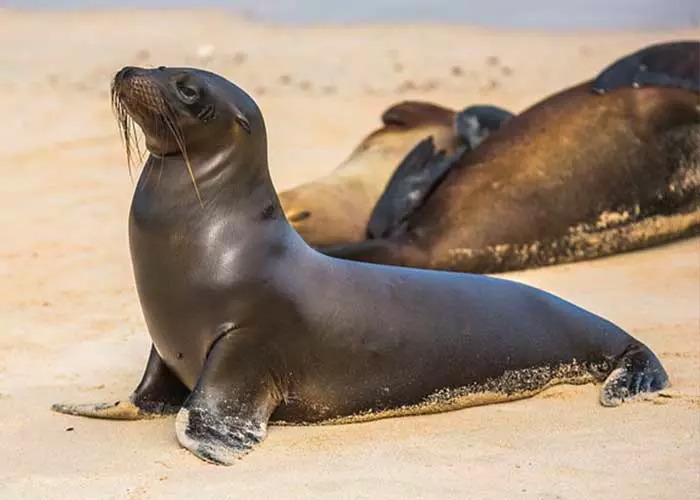
Animals That Look Like Sea Lions
Brown Fur Seal
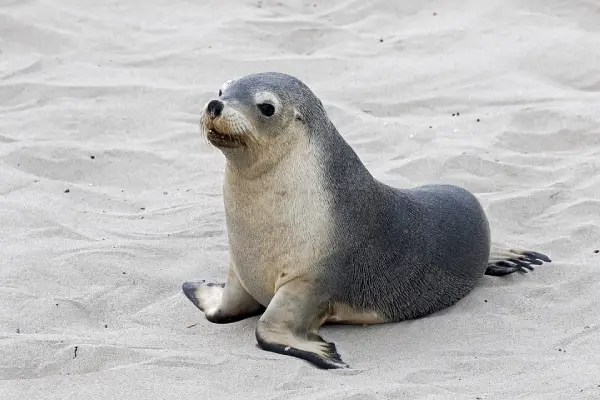
- Scientific name: Arctocephalus pusillus
- Size: 47-71 in
- Weight: 80-660 lb
- Found In: Africa and Australia
Brown fur seals are known under several names like Cape fur seals, South African fur seals, and Australian fur seals.
They are extremely large species of fur seals that are closely related to sea lions, hence their similarities.
Brown fur seals and sea lions both have external ears, long and strong flippers, and can walk on all four. Males are a lot bigger than females but the size depends on the region – African subspecies tend to grow larger than the Australian ones.
Brown fur seals are carnivores and mostly feed on fish, squid, and crabs – they will occasionally attack and eat sharks by swimming in large groups and harassing them!
They dive for food, up to 650 feet, and stay there for over 7 minutes. These social animals spend most of the time at sea, but will often make breeding colonies ranging from 500 to 1,500 animals.
Sea Otter
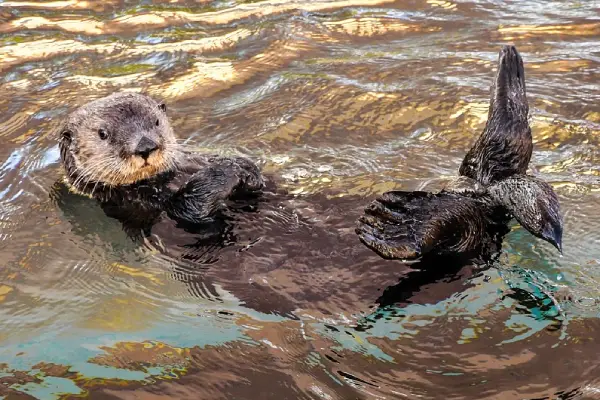
- Scientific name: Enhydra lutris
- Size: 47-59 in
- Weight: 31-99 lb
- Found In: North America and Asia
With weights of up to 100 pounds, sea otters are the heaviest members of the weasel family.
They aren’t the closest relatives to sea lions but share some similarities with them when it comes to body shape and appearance.
Sea otters are native to the coasts of the northern and eastern North Pacific Ocean, in the United States, Mexico, Japan, Russia, and British Columbia.
These incredibly intelligent and social animals are one of the 12 species of otters that exist today, including spotted-necked otters, marine otters, African clawless otters, and many others.
The 13th species, the Japanese river otter, was declared extinct in 2012.
Sea otters have been hunted for their pelts since at least the 17th century; around the 18th century, thousands of them died during the California fur rush.
Otter fur is unique because it is the densest among animals. It is said that there are between 800,000 and 1 million individual hairs per square inch of otter fur.
These animals are also very adapted to swimming and hunting in water.
Because of their webbed feet and strong bodies, sea otters can reach a top swimming speed of around 6 mph – this is similar to the record Michael Phelps achieved in 2010 in freestyle swimming!
They are also very useful animals that help fight climate change.
Sea otters feed on sea urchins. Sea urchins eat massive amounts of seaweed; seaweed helps fight climate change by absorbing carbon emissions. More otters mean fewer sea urchins, more seaweed, and less global warming.
But, otters are not as brilliant as it seems. They are known to attack humans, hold each other’s pups hostage for food, kill animals for fun, and do lots of other disturbing things.
Read More: How do otters reproduce?
Northern Fur Seal

- Scientific name: Callorhinus ursinus
- Size: 56-84 in
- Weight: 88-600 lb
- Found In: North America and Asia
Northern fur seals are eared seals found along the Northern Pacific Ocean, the sea of Okhotsk, and the Bering sea.
They are pelagic species which means that they spend most of their time in the open ocean and only come to land to breed or when sick.
Northern fur seals are similar in appearance to sea lions due to their flippers, visible ear flaps, and coat colors – pups are born with a black pelt that resembles sea lions’ and as they grow, their coat becomes dark brown with lighter colors on their chests and bellies.
Northern fur seals spend 80% of their lifetime in open ocean habitats where they feed on fish and squid. Their list of predators includes sharks, killer whales, and occasionally sea lions that might eat very young animals.
Northern fur seals are listed as Vulnerable by the International Union for Conservation of Nature (IUCN) with an estimated global population of 1 million individuals that is declining.
Walrus
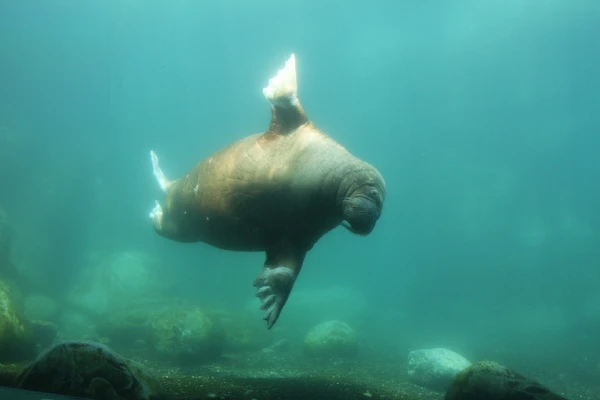
- Scientific name: Odobenus rosmarus
- Size: 12 ft
- Weight: 2,200-4,400 lb
- Found In: North America, Asia, and Europe
Walruses are large marine mammals that live in freezing waters near the Arctic Circle.
They are gregarious and sometimes live in groups of up to 100 animals. These large flippered marine mammals are hard to miss due to their prominent tusks and whiskers; walruses usually have a dark brown or reddish-brown color.
Sea lions and walruses are both winged foot animals that belong to the same group of animals (Pinnipeds). Walruses are born without tusks which means that they most resemble sea lions in the first 5 to 6 months of their lives.
Walruses are almost two times heavier than bears, but that doesn’t stop bears from occasionally attacking them.
There are 2 walrus species: the Pacific walrus and the Atlantic walrus.
Pacific walruses are spread from Russia to the US (Alaska), ranging from the Bering to the Chukchi Seas, as well as the Laptev Sea.
Atlantic walruses inhabit the ice-covered northern waters of Canada, Greenland, Norway, and Russia.
Females are very protective of their young and will pick them up with their flippers and hold them in their chests as they dive into the water to escape danger.
Walruses are carnivores and consume worms, snails, crabs, shrimp, clams, and mollusks.
New Zealand Fur Seal

- Scientific name: Arctocephalus forsteri
- Size: 39-98 in
- Weight: 66-350 lb
- Found In: Australia and New Zealand
These medium-sized seals with long whiskers and two layers of fur are native to Australia and New Zealand.
New Zealand fur seals, just like sea lions, have external ears, flippers, pointed noses, and dark coats.
Compared to other fur seals, they can dive deeper and longer – some adult New Zealand fur seals can reach depths of about 1250 feet and stay there for about 15 minutes!
Most of their time is spent on rocky shores, in breeding colonies where they become very noisy.
These sea lion lookalikes are carnivores and feed on octopus, squid, fish, and birds – some individuals might also eat penguins!
They share habitats with New Zealand sea lions who are known to hunt New Zealand fur seal puppies; their other predators include sharks and killer whales.
Read More: Examples of dogs that look like pigs
Leopard Seal

- Scientific name: Hydrurga leptonyx
- Size: 7.9–11.5 ft
- Weight: 440-1,320 lb
- Found In: Antarctica
Leopard seals, also known as sea leopards, are the second largest seal species in the Antarctic (after southern elephant seals).
These earless seals with very long and muscular bodies have distinctive and massive jaws with sharp teeth. Due to their curved mouths, these seals might give an impression of smiling or grinning menacingly.
Females are bigger than males and reach incredible 1,320 pounds – they were named after the distinctive spotted leopard patterns of their coats.
Just like their feline namesakes, leopard seals are excellent predators and prey on seals, fish, and squid – their only natural predators are killer whales.
They are mostly solitary animals rarely found in groups of more than one or two seals, except when the breeding season comes.
Their long and slender bodies, large foreflippers, and pointy heads are what make them resemble sea lions the most.
Southern Elephant Seal

- Scientific name: Mirounga leonina
- Size: 8.5-19 ft
- Weight: 880-8,800 lb
- Found In: Antarctic and subantarctic region
Southern elephant seals are one of the largest marine mammals in the world.
Males (bulls) can range from 4,900 to 8,800 pounds with 5-6 times smaller females that reach 880-1,980 pounds – the heaviest ever recorded southern elephant seal was 22.5 feet long and weighed around 11,000 pounds!
Despite all of that, they were named after their trunklike snouts, not their size. These snouts serve as a megaphone to make loud sounds and assert dominance over rivals.
Southern elephant seals inhabit the Antarctic and sub-Antarctic water with extremely cold conditions and lots of squids, fish, and other food these seals eat.
Studies have shown their populations in 3 locations: South Atlantic (400,000 animals), the south Indian Ocean (200,000 animals), and the Pacific Ocean (75,000 animals).
Pups are born with black coats and most resemble sea lions in that period.
Besides sea lions, some similarities can be found between elephant seals and anteaters; check the full list of other animals resembling them here.
Dugong
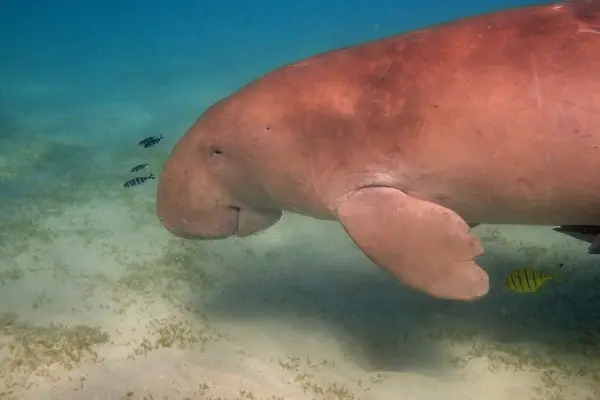
- Scientific name: Dugong dugon
- Size: up to 10 ft
- Weight: 550-1,980 lb
- Found In: Australia, Asia, and Africa
Dugongs are large herbivorous mammals found in warm coastal waters from East Africa to Australia.
They are commonly known as sea cows and love to graze on sea grasses in shallow coastal waters.
Despite being much bigger, dugongs mostly resemble sea lions due to their paddle-like foreflippers and elongated bodies.
Dugongs are related to manatees and have fluked whale-like tails. They are mostly solitary animals found alone or in pairs that might gather in large groups of around a hundred animals but only for a short time.
They can go underwater for 6 minutes and reach depths of around 130 feet. Dugongs communicate by barking, whistling, chirping, or making other sounds that echo underwater.
People were hunting them for their skin, bones, teeth, meat, and oil, although they are now protected throughout their range.
According to some beliefs, dugongs were the inspiration for the tales of sirens and mermaids.
Ribbon Seal
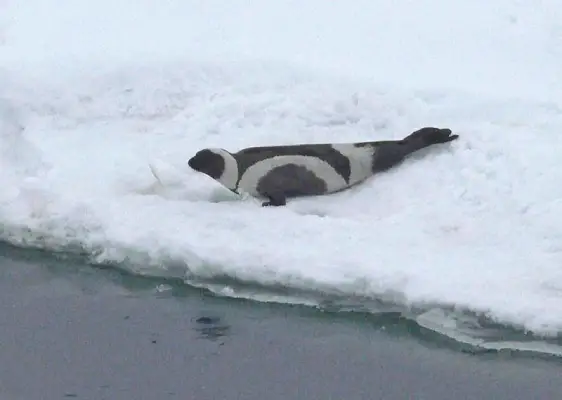
- Scientific name: Histriophoca fasciata
- Size: 65-69 in
- Weight: 159-198 lb
- Found In: North America and Asia
One the most striking and easily recognizable seals in the world, ribbon seals were named after their black skin with white markings.
They have 4 strips, around their necks, tails, and on each body side. These animals resemble sea lions a lot due to sharing similar body shapes and foreflippers.
What makes them unique is an inflatable air sac on the right side of their ribs. Other seals don’t have that and its function is unknown (scientists speculate that it might be used to produce underwater sounds and to attract mates).
Ribbon seals inhabit the north Pacific Ocean and some adjacent Arctic Ocean parts. They are mostly solitary and spend lots of their time in the open ocean.
Rarest and most elusive of the ice seals, ribbon seals feed on fish, shrimp, crabs, and squids.
Due to accelerated climate change and human activities (oil and gas development and hunting), these seals are being threatened with some scientists claiming a 40% loss of these seals’ range by 2050.
Read More: List of animals that resemble chinchillas
Vaquita

- Scientific name: Phocoena sinus
- Size: 4.6-4.9 ft
- Weight: 60-150 lb
- Found In: North America
Vaquitas are one of the most endangered animals in the world with less than 10 alive as of 2022.
They are endemic to the Gulf of California and their 4.6-4.9 ft length makes them the smallest cetaceans.
Vaquitas were first discovered in 1958 and show some resemblances to sea lions. They have small bodies with tall dorsal fins, rounded heads, dark rings around their eyes, and gray color.
These timid and highly elusive marine mammals are carnivores and feed on fish, shrimp, squid, and octopuses.
Bearded Seal

- Scientific name: Erignathus barbatus
- Size: 6.9-89 ft
- Weight: 440-950 lb
- Found In: Arctic Ocean
Bearded seals, also known as square flipper seals, are sea dog lookalikes that live in the Arctic Ocean.
They were named after their long and conspicuous whiskers. These earless seals have square fore flippers, greyish-brown color, and occasionally reddish-brown faces.
Bearded seals are the largest species of Arctic seals that can reach 950 pounds – females are bigger than males.
Their total body fat ranges from 25% to 40% which makes them a major food source for polar bears. Bearded seals have a rather long life and can reach almost 30 years.
Their pups can swim and dive in the first couple of hours of being born.
Summary
This concludes our list of animals that look like sea lions.
Examples include several species of seals, otters, walruses, and many others.
We hope you enjoyed our article; if you did, feel free to check: List of animals that look like buffalos and List of animals that look like groundhogs